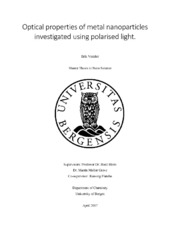Optical properties of metal nanoparticles investigated using polarised light.
Master thesis
Permanent lenke
https://hdl.handle.net/1956/15972Utgivelsesdato
2017-06-10Metadata
Vis full innførselSamlinger
- Department of Chemistry [433]
Sammendrag
The number of applications of metal nanoparticles (MNPs) are growing, and one of their most interesting properties is the interactions between MNPs and light. Especially in the visible regime, MNPs are very good at absorbing light at specific wavelengths, which opens interesting opportunities for use in many technological branches ranging from quantum dot displays to solar energy conversion. The principle behind the light absorption is the localised surface plasmon (LSPR) effect, in which the oscillating electric field of the light wave excites the electrons of the particle. The resonance of these oscillations is dependent on the size, shape, metal type and surrounding medium of the particle, and as such these parameters can be tailored depending on the application. Because of the surrounding mediums effect on the resonance wavelength, nanoparticles can be used in sensors to detect changes in refractive index. The goal of this thesis work is to investigate the viability of nanoparticle arrays as sensor devices, and more specifically explore a phenomenon in which the LSPR is selectively supressed to decrease the width of the plasmon peak, enhancing the sensitivity of potential sensor applications. Large arrays (1 x 1 mm) of gold nanoparticles with varying interparticle distances were fabricated using electron beam lithography (EBL), and the fabrication process was iteratively improved due to an initial lack of particle adhesion to the substrate surface, resulting in samples with a quality high enough to perform optical measurements. The particles were analysed by means of transmission spectroscopy, employing both polarised and unpolarised light, the former using a novel spectrometer. The measurements presented here are the first measurements carried out with polarised light at the UiB nanostructures laboratory. The results demonstrate the suppression of the LSPR, and the spectral positions of these suppression dips, as well as the relationship between the optical response of the particles when subjected to polarised light as compared to unpolarised light. This lays the foundation for further investigation into a refractive index sensor based on nanoparticles.
